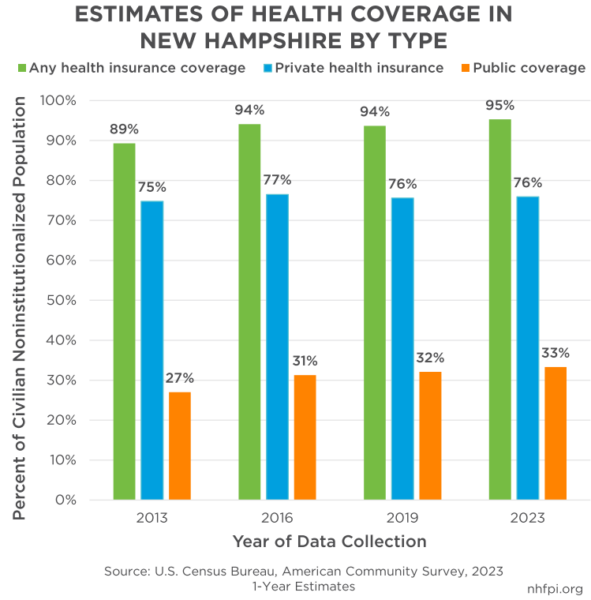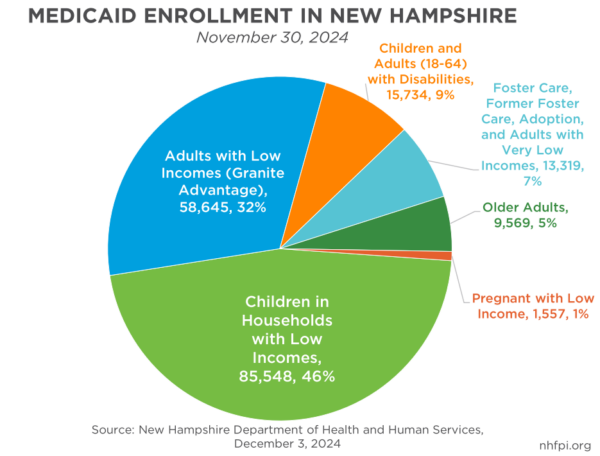This fact sheet provides a snapshot of public health and health coverage in New Hampshire.
Health Care Costs Remain Significant for Granite State Families
- The Massachusetts Institute of Technology estimated a family of two adults and one child in New Hampshire would pay about $9,572 annually for medical costs, or about 12 percent of median household income for three-person families in 2023.[1] The Commonwealth Fund estimated average employee premiums and deductibles combined in the state were $8,579 in 2020.[2]
- Medical care spending per person on personal health care, including public and private insurance expenditures, totaled $11,793 during 2020 in New Hampshire. That amount was the 11th highest expenditure amount among the 50 states, but was the second-lowest among New England states. From 1991 to 2020, annual per capita personal health care expenditures grew faster in New Hampshire than in New England overall, and nationally: growth was behind only Vermont in the region.[3]
Health Coverage During 2023
- The uninsured rate in New Hampshire declined by about half between 2013 and 2022, reflecting the Patient Protection and Affordable Care Act, the State’s 2014 Medicaid Expansion, Medicaid coverage expansions during the COVID-19 pandemic, and more state residents aging into Medicare eligibility. Private insurance has covered a relatively consistent percentage of the population.[4]
- Medicare eligibility typically begins at age 65. Medicare coverage will likely continue to increase in importance during the next decade, as an estimated 213,900 Granite Staters, 15.3 percent of the population, were between the ages of 55 and 64 in July 2023.[5]

Medicaid Enrollment
- Around 184,000 Granite Staters are enrolled in Medicaid during any given month, providing health care coverage for adults and children in households with low incomes, people experiencing a disability, those who were pregnant, and children in foster care or former foster care, among other eligible populations.
- As of November 2024, slightly less than half of the state’s Medicaid population were children, and about one-third were adults receiving coverage through the Granite Advantage Health Care Program.[6]

Health Care Workforce
- Employment in health care and social assistance, the state’s largest employment sector, was about 5,782 positions (6.1 percent) higher on average during the first 11 months of 2024 than it was in 2019.
- Between April 2020 and July 2024, New Hampshire’s population grew by approximately 31,486 people (2.3 percent), suggesting population growth did not outpace the number of filled health care jobs after falling behind during the COVID-19 pandemic.[7]
Health Costs Rising
- More Granite Staters have health insurance deductibles, and the majority of small-group and large-group family deductibles exceeded $3,000. Average family premiums and deductibles accounted for almost half (49 percent) of statewide average wages.[8]
- Difficulty affording health services may be increasing, with an official survey indicating 11 percent of Granite Staters could not see a doctor due to cost in 2021, but a separate, private survey finding 71 percent delayed or went without needed care due to cost in 2024.[9]
- Hospital and other health system consolidation may lead to higher health care costs for families, as well as reduced availability among services and providers.[10]
[1] Massachusetts Institute of Technology, Living Wage Calculator; U.S. Census Bureau, American Community Survey, 2023 Estimates, Table S1903.
[2] The Commonwealth Fund, State Trends in Employer Premiums and Deductibles, 2010-2020, January 12, 2022.
[3] Kaiser Family Foundation, Health Care Expenditures per Capita by State of Residence: 2020, accessed January 2025; U.S. Center for Medicare and Medicaid Services, Health Expenditures by State of Residence: 1991-2020, accessed January 2025.
[4] U.S. Census Bureau, American Community Survey, Tables CP03 and S2704; NHFPI, The Effects of Medicaid Expansion in New Hampshire, January 17, 2023; University of Wisconsin-Madison La Follette Policy Report, U.S. Health-Care Reform: A Primer and an Assessment, Spring 2011; U.S. Congressional Budget Office, CBO and JCT’s Estimates of the Effects of the Affordable Care Act on the Number of People Obtaining Employment-Based Health Insurance, March 2012.
[5] U.S. Census Bureau, Population Estimates Program – Vintage 2023; Kaiser Family Foundation, An Overview of Medicare, February 13, 2019.
[6] New Hampshire Department of Health and Human Services, Medicaid Enrollment Demographic Trends and Geography, December 3, 2024.
[7] New Hampshire Employment Security, Current Employment Statistics, accessed November 2024. U.S. Census Bureau, Population Estimates Program, County Population Totals and Components of Change: 2020-2024, accessed November 2024.
[8] See the University of New Hampshire’s June 14, 2024 report, Healthcare Cost and Activity in New Hampshire.
[9] See the University of New Hampshire’s June 14, 2024 report, Healthcare Cost and Activity in New Hampshire; New Future’s December 11, 2024 article, New Poll Results Show Rising Health Care Costs Impacting Physical, Financial Health of New Hampshire Residents.
[10] See the University of New Hampshire’s August 15, 2024 report, Hospital Mergers Have Changed the Healthcare Landscape.
